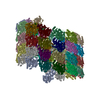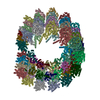+Search query
-Structure paper
| Title | Cryo-ET of parasites gives subnanometer insight into tubulin-based structures. |
|---|---|
| Journal, issue, pages | Proc Natl Acad Sci U S A, Vol. 119, Issue 6, Year 2022 |
| Publish date | Feb 8, 2022 |
 Authors Authors | Stella Y Sun / Li-Av Segev-Zarko / Muyuan Chen / Grigore D Pintilie / Michael F Schmid / Steven J Ludtke / John C Boothroyd / Wah Chiu /  |
| PubMed Abstract | Tubulin is a conserved protein that polymerizes into different forms of filamentous structures in , an obligate intracellular parasite in the phylum Apicomplexa. Two key tubulin-containing ...Tubulin is a conserved protein that polymerizes into different forms of filamentous structures in , an obligate intracellular parasite in the phylum Apicomplexa. Two key tubulin-containing cytoskeletal components are subpellicular microtubules (SPMTs) and conoid fibrils (CFs). The SPMTs help maintain shape and gliding motility, while the CFs are implicated in invasion. Here, we use cryogenic electron tomography to determine the molecular structures of the SPMTs and CFs in vitrified intact and detergent-extracted parasites. Subvolume densities from detergent-extracted parasites yielded averaged density maps at subnanometer resolutions, and these were related back to their architecture in situ. An intralumenal spiral lines the interior of the 13-protofilament SPMTs, revealing a preferred orientation of these microtubules relative to the parasite's long axis. Each CF is composed of nine tubulin protofilaments that display a comma-shaped cross-section, plus additional associated components. Conoid protrusion, a crucial step in invasion, is associated with an altered pitch of each CF. The use of basic building blocks of protofilaments and different accessory proteins in one organism illustrates the versatility of tubulin to form two distinct types of assemblies, SPMTs and CFs. |
 External links External links |  Proc Natl Acad Sci U S A / Proc Natl Acad Sci U S A /  PubMed:35121661 / PubMed:35121661 /  PubMed Central PubMed Central |
| Methods | EM (tomography) / EM (subtomogram averaging) |
| Resolution | 6.7 - 46.0 Å |
| Structure data |  EMDB-26006:  EMDB-26007:  EMDB-26008:  EMDB-26009:  EMDB-26010: EMDB-26018, PDB-7tnq: EMDB-26019, PDB-7tns: EMDB-26020, PDB-7tnt: |
| Source |
|
 Keywords Keywords | CELL INVASION /  parasites / parasites /  Toxoplasma gondii / Toxoplasma gondii /  cytoskeleton / cytoskeleton /  microtubules / microtubules /  tubulin / tubulin /  conoid conoid |
 Movie
Movie Controller
Controller Structure viewers
Structure viewers About Yorodumi Papers
About Yorodumi Papers










